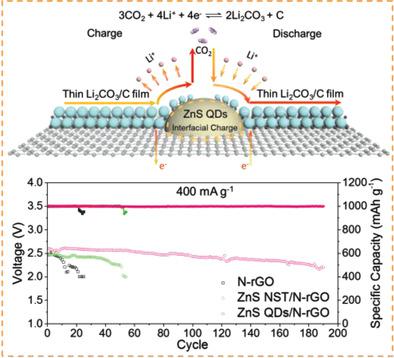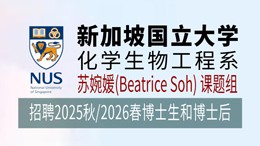当前位置:
X-MOL 学术
›
Adv. Energy Mater.
›
论文详情
Our official English website, www.x-mol.net, welcomes your feedback! (Note: you will need to create a separate account there.)
Realizing Interfacial Electronic Interaction within ZnS Quantum Dots/N‐rGO Heterostructures for Efficient Li–CO2 Batteries
Advanced Energy Materials ( IF 24.4 ) Pub Date : 2019-07-30 , DOI: 10.1002/aenm.201901806 Hui Wang 1 , Keyu Xie 1 , You You 1 , Qian Hou 1 , Kun Zhang 1 , Nan Li 1 , Wei Yu 2 , Kian Ping Loh 2 , Chao Shen 1 , Bingqing Wei 1, 3
Advanced Energy Materials ( IF 24.4 ) Pub Date : 2019-07-30 , DOI: 10.1002/aenm.201901806 Hui Wang 1 , Keyu Xie 1 , You You 1 , Qian Hou 1 , Kun Zhang 1 , Nan Li 1 , Wei Yu 2 , Kian Ping Loh 2 , Chao Shen 1 , Bingqing Wei 1, 3
Affiliation

|
With high theoretical energy density, rechargeable metal–gas batteries (e.g., Li–CO2 battery) are considered as one of the most promising energy storage devices. However, their practical applications are hindered by the sluggish reaction kinetics and discharge product accumulation during battery cycling. Currently, the solutions focus on exploration of new catalysts while the thorough understanding of their underlying mechanisms is often ignored. Herein, the interfacial electronic interaction within rationally designed catalysts, ZnS quantum dots/nitrogen‐doped reduced graphene oxide (ZnS QDs/N‐rGO) heterostructures, and their effects on transformation and deposition of discharge products in the Li–CO2 battery are revealed. In this work, the interfacial interaction can both enhance the catalytic activities of ZnS QDs/N‐rGO heterostructures and induce the nucleation of discharge products to form a homogeneous Li2CO3/C film with excellent electronic transmission and high electrochemical activities. When the batteries cycle within a cutoff specific capacity of 1000 mAh g−1 at a current density of 400 mA g−1, the cycling performance of the Li–CO2 battery using a ZnS QDs/N‐rGO cathode is over 3 and 9 times than those coupled with a ZnS nanosheets (NST)/N‐rGO cathode and a N‐rGO cathode, respectively. This work provides comprehensive understandings on designing catalysts for Li–CO2 batteries as well as other rechargeable metal–gas batteries.
中文翻译:

在高效Li-CO2电池的ZnS量子点/ N-rGO异质结构中实现界面电子相互作用
具有较高的理论能量密度,可再充电金属气电池(例如Li-CO 2电池)被认为是最有前途的储能设备之一。但是,它们的实际应用受到电池循环过程中反应动力学缓慢和放电产物积聚的阻碍。当前,解决方案侧重于对新催化剂的探索,而对它们的潜在机理的透彻了解通常被忽略。在此,合理设计的催化剂之间的界面电子相互作用,ZnS量子点/氮掺杂的还原氧化石墨烯(ZnS QDs / N-rGO)异质结构及其对Li–CO 2中放电产物的转化和沉积的影响电池被揭露。在这项工作中,界面相互作用既可以增强ZnS QDs / N-rGO异质结构的催化活性,又可以诱导放电产物成核,从而形成均质的Li 2 CO 3 / C膜,具有优异的电子传输和高电化学活性。当电池以400 mA g -1的电流密度在1000 mAh g -1的极限比容量内循环时,使用ZnS QDs / N-rGO阴极的Li–CO 2电池的循环性能超过3和9分别是与ZnS纳米片(NST)/ N-rGO阴极和N-rGO阴极耦合的时间的两倍。这项工作为设计Li–CO 2催化剂提供了全面的理解。 电池以及其他可充电金属气电池。
更新日期:2019-07-30
中文翻译:

在高效Li-CO2电池的ZnS量子点/ N-rGO异质结构中实现界面电子相互作用
具有较高的理论能量密度,可再充电金属气电池(例如Li-CO 2电池)被认为是最有前途的储能设备之一。但是,它们的实际应用受到电池循环过程中反应动力学缓慢和放电产物积聚的阻碍。当前,解决方案侧重于对新催化剂的探索,而对它们的潜在机理的透彻了解通常被忽略。在此,合理设计的催化剂之间的界面电子相互作用,ZnS量子点/氮掺杂的还原氧化石墨烯(ZnS QDs / N-rGO)异质结构及其对Li–CO 2中放电产物的转化和沉积的影响电池被揭露。在这项工作中,界面相互作用既可以增强ZnS QDs / N-rGO异质结构的催化活性,又可以诱导放电产物成核,从而形成均质的Li 2 CO 3 / C膜,具有优异的电子传输和高电化学活性。当电池以400 mA g -1的电流密度在1000 mAh g -1的极限比容量内循环时,使用ZnS QDs / N-rGO阴极的Li–CO 2电池的循环性能超过3和9分别是与ZnS纳米片(NST)/ N-rGO阴极和N-rGO阴极耦合的时间的两倍。这项工作为设计Li–CO 2催化剂提供了全面的理解。 电池以及其他可充电金属气电池。
















































 京公网安备 11010802027423号
京公网安备 11010802027423号